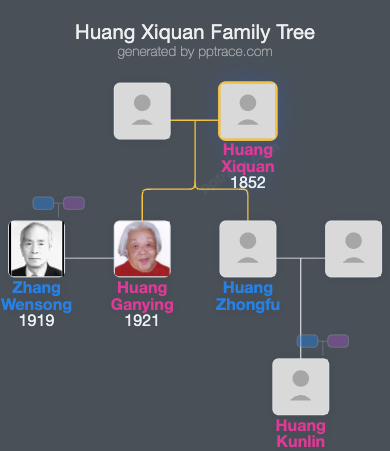
Huang Xiquan
| Name | Huang Xiquan |
| Title | Diplomat |
| Gender | - |
| Birthday | 1852-01-01 |
| nationality | — |
| Source | https://baike.baidu.com/item/%E9%BB%84%E9%94%A1%E9%93%A8/4667785 |
| pptrace | View Family Tree |
| LastUpdate | 2025-10-01T11:03:02.388Z |
Introduction
Huang Xiquan, courtesy name Junxuan, was born in 1852 in Shuicha Village, Shui Che, Jiying Prefecture, Guangdong province. His family name was Nansheng. From a young age, he demonstrated diligent and studious qualities. In the tenth year of the Tongzhi Emperor's reign (1871), he obtained the status of a provincial student and was recommended as an excellent vice tribute student. His early education focused on national affairs and practical knowledge; he personally purchased "Jing Chao" (a type of Chinese banknote) and the "Universal Gazette" to read and promote local awareness of current events and national issues.
In the sixth year of the Guangxu Emperor's reign (1880), Huang Xiquan was appointed as a clerk at the Embassy to Japan. Two years later, he went to America, serving as a first-grade attaché at the Consulate General in San Francisco. In 1882, he was transferred to be the chief consular officer in New York. During this period, he actively protected the rights of Chinese expatriates, handled anti-Chinese incidents, and particularly after the anti-Chinese massacre in Shiyan City, Wyoming, he dispatched investigators and campaigned to urge the U.S. government to pay compensation. This was the first instance of compensation when Chinese immigrants faced persecution abroad in the early 19th century. In 1885, he was transferred to be a second-grade counselor and acting envoy at the embassy in Peru. During his overseas service, he frequently negotiated with host countries on issues such as Chinese immigrants' rights and entry taxes, successfully leading to the abolition of harsh taxes on Chinese immigrants by Canada.
In 1889, Huang Xiquan returned to China and presided over the military affairs office of the maritime defense in Qian shan. Later, he resigned from official posts and dedicated himself to teaching and rural revitalization. After a one-year inspection tour of Southeast Asia, in 1902, he returned to Jiangxi Province and took a position at the Translation and Literature Bureau. He later held several official posts, including deputy director of the Agriculture and Industry Bureau, director of the Jiujiang Tax Bureau, and head of the Hukou Taxation Office. In 1905, he went to Guangxi, serving as the clerk at the Fushou Office, overseeing both foreign affairs and the mining and agriculture industries, promoting local industrial and agricultural development, and establishing a pilot farm for agriculture and forestry, training technical personnel.
He resigned and returned home in 1909, promoted the construction of Shaode School, and advanced rural economic development. He established a towel factory and founded Jiaying Guaicui Company. After the Xinhai Revolution, he participated in the Guangdong Provincial Provisional Parliament, and was elected as a provincial legislator and senator. He also served as an adviser to the Guangdong Governor's Office and principal of the Liangguang Normal School. In the National Assembly, he proposed several important bills related to restoring tariff autonomy, handling foreign property, and issues concerning China-Japan disputes.
Huang Xiquan passed away in Beijing on March 1, 1925, at the age of 74. He was well-read and skilled in calligraphy. His former residence was called "Wanjuan Book House." In terms of family, his son Huang Zhongfu served as the consul general in New York; his daughter Huang Ganying was a member of the Standing Committee of the National Committee of the Chinese People's Political Consultative Conference and deputy secretary of the Women's Federation Party Group; his granddaughter Huang Kunlin was chairperson of the Taishan Women's Federation. His nephew Huang Qixiang was a famous anti-Japanese general and involved in the China Democratic League.
Family Tree
Tap to expand more relatives
